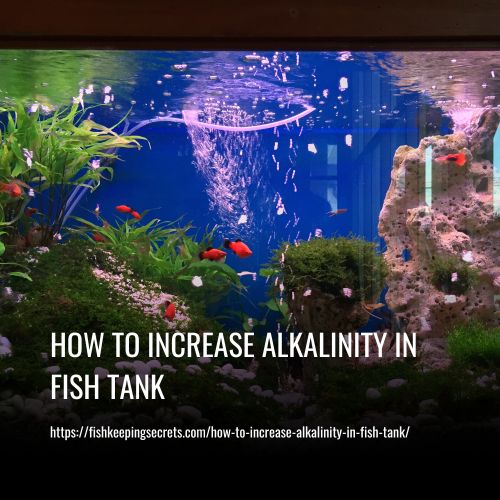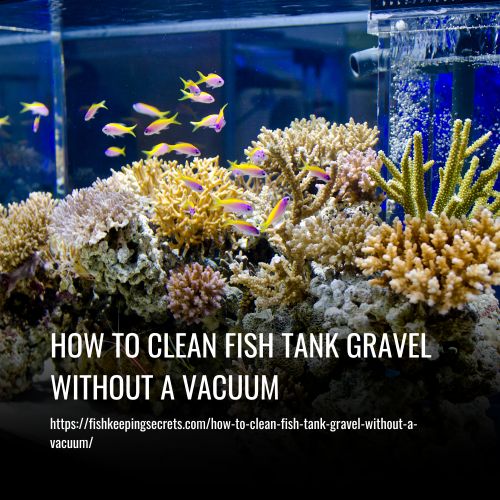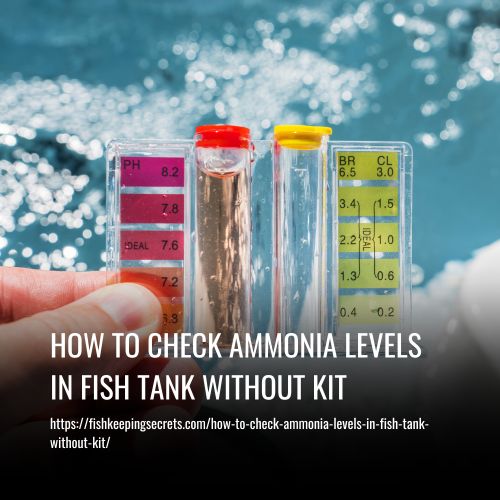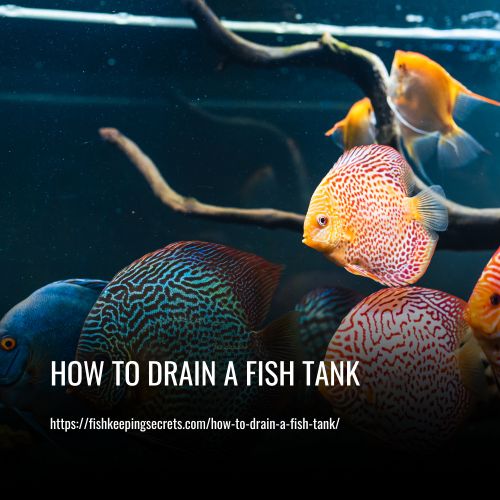How To Increase Alkalinity In Fish Tank
This post contains affiliate links. As an Amazon Associate, we earn from qualifying purchases.
One popular option for increasing alkalinity in fish tanks is using baking soda (sodium bicarbonate) as a chemical buffer. It’s important to note that when adding any chemicals to your tank, you should do so gradually and monitor the pH levels closely to prevent any harm to your fish. With these simple steps, you can easily increase the alkalinity in your fish tank and keep your underwater friends healthy and happy.
Maintaining the right alkalinity level in a fish tank is important for the health of your aquatic pets. If you notice that the alkalinity level is too low, then you can increase it by exchanging a portion of your tank water with new water that has moderate total alkalinity or by adding chemical buffers to your aquarium water.

How Does Alkalinity Affect Fish?
The alkalinity of your aquarium can have a significant impact on the health and well-being of your fish. It’s important to maintain suitable levels to prevent any problems from occurring. When the alkalinity is too low, it can result in a sudden drop in pH which causes stress to the fish and an increase in toxic ammonia levels that can be harmful.
On the other hand, if the alkalinity is too high, it can dissolve the protective mucus layer of the fish making them vulnerable to burns, and bacterial infections and causing them to lose control over their swim bladders.
It is recommended to test the overall alkalinity every month to ensure ideal conditions for both fish and biofiltration systems. If there are frequent changes in pH levels or new additions to your tank, it’s advisable to test more frequently until everything stabilizes. By maintaining the right level of alkalinity in your aquarium, you can keep your fish happy and healthy!
What Is Alkalinity in Fish Tanks?
Water alkalinity is an important factor for maintaining a stable pH in fish tanks. It refers to the capacity of the water to resist acidification and neutralize any acids present in the tank. The presence of hydroxides, carbonates, and bicarbonates can affect alkalinity levels.
In basic terms, alkalinity is a measurement of the quantity of bicarbonate present in water.
This property is particularly crucial in reef aquariums where corals rely on bicarbonate for their survival. It serves as a protective barrier that shields the pH from being affected by acids generated naturally within the tank.
Maintaining an adequate KH, or carbonate hardness which is related to alkalinity helps prevent sudden changes in pH that could be detrimental to fish health. A high KH reduces acidity levels before they can impact the aquarium’s pH. To accurately measure alkalinity levels in a tank, regular testing of the water is necessary.
To keep fish healthy and happy, it’s important to ensure that their environment closely resembles natural conditions with regards to alkalinity balance – neither too high nor too low as this may cause problems for different species depending on their overall health.
The right pH for fish
Maintaining the ideal pH level is essential for the health of your fish, and it’s important that you keep in mind their natural habitat while doing so. To maintain suitable conditions for the fish in a freshwater aquarium, it is recommended to adjust the alkalinity level to match the water of their native habitat.
In general, freshwater fish thrive in conditions ranging from 5.5 to 7.5 pH, whereas saltwater fish require a total alkalinity between 8.0 to 8.1. You can consult a fish pH chart to determine what’s best for your tank, but remember that keeping the tank conditions well-suited for the species you are keeping is crucial.
It’s also essential to plan out your substrate and decor accordingly to support those parameters so that any freshwater fish requiring a pH level of 7.5 doesn’t end up in an environment with a lower pH level of 5.5.
Some telltale signs that your tank might be becoming too acidic for your fish include stunted growth, stress, and gasping while developing physical symptoms under such chronic conditions as eye problems or thickened skin and gills can prove dangerous for them as well.
What Causes Low pH in an Aquarium?
Low pH levels can be caused by a variety of factors, including:
1. Improper Maintenance:
Low pH levels in an aquarium are often caused by improper maintenance. The accumulation of fish waste and uneaten food in tanks may lead to the breakdown of nitrate (NO3-) production, which is characterized by acidity. As nitrate builds up in the water, it lowers the pH level.
To avoid this problem, regular maintenance of your aquarium is crucial. It’s important to clean your tank regularly to prevent waste buildup and monitor nitrate levels to ensure they remain at a safe level for your fish.
You can also refer to our Aquarium Nitrogen Cycle article for more information on how to properly maintain your aquarium and keep it healthy for your fish.
2. Check Your TapWater:
To understand the cause of low pH in your aquarium, it’s important to start with the source: your tap water. Checking the pH of your tap water is highly recommended. If it already has a good pH level, then you can easily bring up the pH in your aquarium by performing regular water changes. Regular water changes can gradually increase the pH to a healthy level, with 50% changes every other day being recommended.
Once that’s achieved, maintaining healthy water parameters becomes easier – usually, just one 50% water change per week will suffice. By being aware of your tap water’s pH, you’re able to create a stable and healthy environment for your aquatic pets.
3. Tannins:
Tannins are organic compounds that can cause a drop in pH in your aquarium. These acidic compounds are commonly found in decor, such as driftwood, that leaches tannins into the water, staining it brown and reducing pH levels.
To prevent this from happening, you can boil the driftwood to release the tannins before adding it to your tank. If you notice a significant amount of tannins in your water, you may need to repeat the boiling process with fresh water until the water stays clear.
Various leaves, including Indian Almond Leaves and alder cones, are well-known sources of tannins. It’s important to be mindful of these organic sources of tannins in your aquarium and take steps to manage their effects on water quality.
4. Poor Aeration:
Poor aeration in an aquarium can contribute to low pH levels, especially in unfiltered Betta tanks. Without proper water flow and surface agitation, the CO2 from fish respiration can accumulate in the water column, leading to a drop in pH. That’s why it is highly recommended that you use a filter in your aquarium, as filters help move water around the tank and promote gas exchange.
Additionally, using an aquarium air pump with an airstone can enhance aeration by creating bubbles that increase water flow and surface agitation. By improving aeration in your aquarium, you can prevent low pH levels and maintain a healthy environment for your fish.
Is Low pH Bad for Fish?
Low pH levels can hurt fish, but it’s important to define what “low pH” actually means. Usually, a pH level below 6.5 is considered low for most species of fish found in the aquarium trade, as they don’t do well in highly acidic water. Additionally, once the pH drops below 6.5, the water loses its buffering capacity, which can lead to an even lower pH level.
However, it’s not necessary to constantly adjust your water parameters based on what you read in articles or blogs about ideal numbers for different kinds of fish. Most species are capable of adapting to a range of parameters if they’re acclimated properly and you maintain consistency in your tank conditions.
While it’s good to understand the natural habitat conditions for different species of fish and aim to replicate them to some extent, providing a well-cycled aquarium with stable temperature and regular maintenance routines are more important for their overall health than hitting perfect numerical values for things like pH or KH.
Therefore, unless your tank has an extremely low pH level that’s harmful to your specific fish species, trying to raise the pH unnaturally is unnecessary and potentially disruptive to their environment.
Can High Alkalinity Kill Fish?
High alkalinity levels in fish tanks can be dangerous for fish. Although they can tolerate a certain level of alkalinity, it’s important to control the amount to prevent harm to the fish. If there is too much alkalinity in your fish tank and it lasts for an extended period, it can dissolve the protective layer of mucus that covers the fish. This makes them susceptible to infections and bacterial-related health problems such as eye damage, thickening of skin and gills, as well as gasping for air.
Additionally, high levels of alkalinity can interfere with fish swimming by causing them to lose control over their swim bladders. This prevents them from swimming properly and causes symptoms such as poor buoyancy, a distended belly, loss of appetite, lethargy, and stress.
Younger fish are more sensitive to high alkalinity levels than adult fish. Thus if you have new or newly hatched fish in your tank you must monitor the water closely to safeguard their health since extreme pH levels may prevent eggs from hatching or cause them to die.
What Does Low Alkalinity in a Fish Tank Mean?
Low alkalinity in a fish tank is an indication of a problem within the tank. It may not be a significant issue at first, but if left unaddressed, it can lead to adverse conditions that will harm your fish.
Several factors can cause low alkalinity in a fish tank, including water changes, decreased aeration, driftwood that softens the water, added CO2, high nitrites, pollutants, and waste, and using a water purifier. To identify the root cause of the problem, consider whether you have made any changes to your aquarium recently or if you have used any new products while cleaning it.
Once you’ve identified the issue causing the low alkalinity levels in your aquarium, take steps to address and fix it; this will protect your fish from further harm.
Why Is the Alkalinity High in My Fish Tank?
If you notice that the alkalinity levels in your fish tank are high, it could be an indication that something is wrong. The potential culprits for this issue are varied and include crushed coral substrate or ornaments, calcium-rich materials like limestone, hard water, ineffective or old filters, trapped CO2 and nitrites from aquatic plants, as well as fish waste and other organic materials.
Identifying the exact cause of elevated alkalinity levels can be a challenge and may require further investigation and testing. One common reason for high alkalinity levels is tap water which may have different alkalinity levels than the water already present in your tank.
Adding untreated tap water to your aquarium can lead to harmful pH levels for the fish. Thus before adding it to your tank, you should treat it by letting it sit for 24 hours to allow the chemicals to evaporate or using a reverse osmosis unit (RO) to dissolve solids that contribute to pH levels. Boiling and aerating tap water can also help raise their safety levels when used in a fish tank setup.
How Do I Fix the Alkalinity in a Fish Tank?
Maintaining the proper pH levels in your fish tank is crucial to keeping your fish healthy and happy. To address any issues with alkalinity, you need to first determine your current pH levels and what pH level is best for your fish.
If you notice a change in the pH level of your tank, it’s important to act quickly to restore it to safe levels. To increase or decrease alkalinity, there are steps you can take.
1. Increase the Alkalinity:
If the alkalinity is insufficient, it may be necessary to raise it in order to create a more favorable environment for fish. The following steps can assist you in achieving this goal.
2. Water Change:
One solution to fix the alkalinity levels in your fish tank is through regular water changes. Neglecting to do so can cause an imbalance in your tank’s chemical equilibrium, which can be harmful to your fish. It is recommended to avoid changing all the water at once in a tank, as it may eliminate the advantageous bacteria present in it.
To maintain a healthy tank for your fish it’s recommended to follow a schedule of water changes. For those with a robust filtration system or a minimal fish population, changing the water once a month may suffice.
If not, consider changing about 30% at a time every two weeks, 15-20% weekly, or 5-10% twice a week depending on various factors such as the number and type of fish you have, and how often they are fed. This will help keep the alkalinity levels stable in your tank while maintaining a healthy environment for your aquatic pets.
3. Change Substrate:
One way to address high alkalinity in your fish tank is by changing the substrate. Natural substrates such as limestone, seashells, and crushed coral can increase the alkalinity of your tank. By replacing your current substrate with one of these options, you may be able to bring down the alkalinity levels.
It’s important to note that you should add this new substrate gradually. Changing it too quickly can cause a sudden shift in pH and alkalinity that can be harmful to your fish. Therefore, it’s best to take things slow and monitor how the new substrate impacts your tank before adding more.
4. Increase Aeration:
Maintaining the right alkalinity levels is essential in ensuring that your fish tank remains healthy. One way to fix the alkalinity in your fish tank is by increasing aeration. By doing this, you can naturally reduce carbon dioxide and increase oxygen levels, which raises both the alkalinity and pH.
There are several devices you can use to achieve this. A surface bubbler releases streams of bubbles and oxygen into the tank, while a HOB filter hangs at the back of the tank and releases water into it from above. Powerheads create more water flow, while wavemakers agitate the water’s surface, creating waves.
The aquarium receives its water supply via spray bars and sprinklers. You only need one device but any of them will do an excellent job of increasing oxygen levels within your fish tank.
5. Use Baking Soda:
One effective way to address low alkalinity levels in a fish tank is by using baking soda. This may come as a surprise, but it has proven to be a common and reliable method. To do this, simply dissolve one teaspoon of baking soda in water for every 5 gallons in your tank (some suggest using one teaspoon per 10 gallons, but it’s best to assess what is suitable for your specific tank).
After introducing the solution to the tank, allow 24 hours to pass before assessing any changes in the alkalinity levels. It’s important to regularly test your water’s alkalinity levels since several factors can cause them to fluctuate at any moment. Take action as soon as you notice any changes and maintain a balanced environment for your fish!
FAQs
Alkalinity helps stabilize pH levels in the water, ensuring a suitable and consistent environment for fish and other aquatic life. It also supports the health of beneficial bacteria that aid in biological filtration.
Low alkalinity can manifest as fluctuating pH levels, which can stress fish and inhibit the growth of coral and other aquatic organisms. Algae blooms, coral bleaching, and decreased buffer capacity are also potential indicators of low alkalinity.
You can increase alkalinity by adding alkaline buffers or supplements specifically designed for aquarium use. These products typically contain carbonate and bicarbonate compounds that raise alkalinity without significantly affecting pH.
The ideal alkalinity range for most freshwater aquariums is between 80 to 120 ppm (parts per million), while for reef tanks or marine aquariums, the recommended range is typically higher, around 125 to 200 ppm.
Regular monitoring of alkalinity is crucial, especially in reef tanks or systems with coral, as they are more sensitive to fluctuations. Testing alkalinity weekly is recommended, with adjustments made as needed to maintain stable levels.
Yes, natural methods include using crushed coral or limestone as substrate, which slowly releases alkaline minerals into the water. Additionally, maintaining a healthy population of calcareous algae or dosing with kalkwasser (calcium hydroxide) can help boost alkalinity naturally over time. However, it’s essential to monitor alkalinity levels closely when using these methods to prevent sudden spikes or drops.
Conclusion:
Maintaining the right pH levels in your fish tank is essential for the health of your aquatic pets. Keeping an eye on alkalinity levels and taking steps to increase them when necessary can ensure that your fish thrive in a safe and healthy environment.
Whether you choose to use commercial products or natural additives, remember to test your water regularly and make changes as needed to keep your aquarium’s pH levels balanced. With a little bit of effort, you’ll be able to enjoy the beauty and serenity of your underwater world for years to come.






